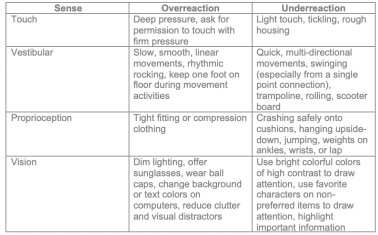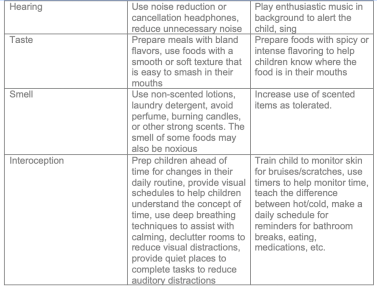
Source: DjelicS / Getty
How many of you have heard of children having sensory processing difficulties and wondered, “What does that mean?” A simplified answer is that first our bodies receive information from the environment through our senses. This information travels to our brains where the information is processed; then, a decision is made within a split second as to whether the information is safe or harmful to us based on past experiences, as well as feelings of pleasure or pain associated with the information. Then, our brains send messages to our body to react to the information appropriately.
For example, if a person touches a hot stove, within milliseconds, our body responds by withdrawing to protect ourselves. Another example would be when a person receives a hug from loved one. Typically, people relax and have a sense of happiness.
The 8 Senses. What! I’ve only heard of 5!
We all grew up learning about the five senses of vision, hearing, smell, taste, and touch/tactile. In terms of sensory processing, there are two other hidden sensations that work closely with our sense of touch or tactile processing to unconsciously help our bodies function on daily basis. Let’s first define the tactile sense which includes anything that touches our skin, as well as feeling the shape, texture, and size of objects. The tactile sense also includes knowing when we are touched and whether it’s dangerous or not.
The first new sense is called the vestibular sense where information about our balance and movement in relation to the earth is processed within our inner ears. For example, when we ride amusement park rides, our vestibular system is working heavily to help us know when we are moving forward, backward, upside-down, or side to side. It is also the system that helps us regain our balance when we trip.
The second new sense is called the proprioception sense which helps us know how our body parts are positioned and what we are doing through information gained from our muscles, joints, and ligament positions without looking. Think about when you enter your house at night, you reach to find the light switch in the dark, and voila! You skillfully turn the lights on without fumbling. Your body automatically remembers the location of the light switch because of your proprioception sense in action! These 3 senses work seamlessly together with the help of the other four common senses to help us function throughout our day!
There is one other newly named eighth sense that is key to knowing what is happening inside of our bodies called the interoception sense. This is simply defined as the awareness of our internal body systems such as hunger, thirst, the urge to use the restroom, breathing rate, heart rate, pain (stomachache, headache, knee, shoulder, etc.), itch, feeling hot or cold, or any other internal feeling that gives us information about the condition of our body. This sense is closely related to our emotional experiences. Without understanding how we feel inside, it’s almost impossible to understand what emotions we are experiencing.
Ok, So What Can I Do with This New Information?
All of our senses function within a spectrum of highs, lows, and balanced, and all people are constantly flowing throughout the spectrum depending on what we are experiencing. Some things that may bother some people may not be a problem for others. For example, some people do not like the feel of cotton balls. Some people do not like the taste of green beans. Having these differences or reactions to these items do not disrupt our day because we can learn to manage our reactions to these things or simply avoid them. Other people may have a fear of heights or get car sick. We all can name something that bothers us or that we dislike.
Problems with sensory processing arise when the body strongly misinterprets the sensory signals by either inappropriately overreacting or underreacting to the experience. People can respond with over-sensitivity and react strongly by demonstrating refusals, tantrums, screaming, hitting, etc., and other people may not even register or be aware of what is happening and appear to be ignoring you, not respond when their name is called, sit quietly while doing nothing, be lost in their own thoughts, etc. unless they receive extra or extreme amounts information from the environment. So how can we help? The chart below shows examples of how to improve or balance sensory processing for each sense.


Source: Lori Messina
Whoa! That’s a lot! I thought it was all behavior!
The recommendations above are simple, basic examples of where to start with managing sensory processing difficulties, and these difficulties can greatly impact your child’s overall behavior and their ability to communicate their needs. Many times, disruptions with sensory processing can be the root cause of the behaviors seen in children. For instance, let’s say a child is refusing to get dressed in the mornings, and will only dress if they wear a particular set of clothing. The battle is real, as the parent uses every trick they know to get this child dressed for the day and they wonder why getting dressed is such a trigger for negative behaviors.
In reality, what we see as a behavior may not be a “behavior” at all, but rather a REACTION to a sensory sensitivity to certain fabrics. There are kids that process the feeling of some clothing textures as feeling like sandpaper against their skin! Ouch! As we know, all people are different and solutions or strategies that for may work for one child may not work for others. The key is to keep experimenting with strategies until you find what works best for your child. Once you do this, you will be on the road to learning how to help your child to find the tools to reach a “just right” balance that leads to self-regulation.
For more information, pediatric occupational therapists are great resources for understanding sensory processing. They have a vast knowledge about this topic and may be able to help.
Additional Resources:
The Out-of-Sync Child by Carol Kranowitz
Interoception: The Eighth Sensory System by Kelly Mahler
Lori Messina is an Occupational Therapist who has worked with children and adults in various settings such as home health, private clinics, outpatient clinics, and school districts. She currently works in a school-based setting, and continues to work individually with families during the summers through home-based or consultative services.









